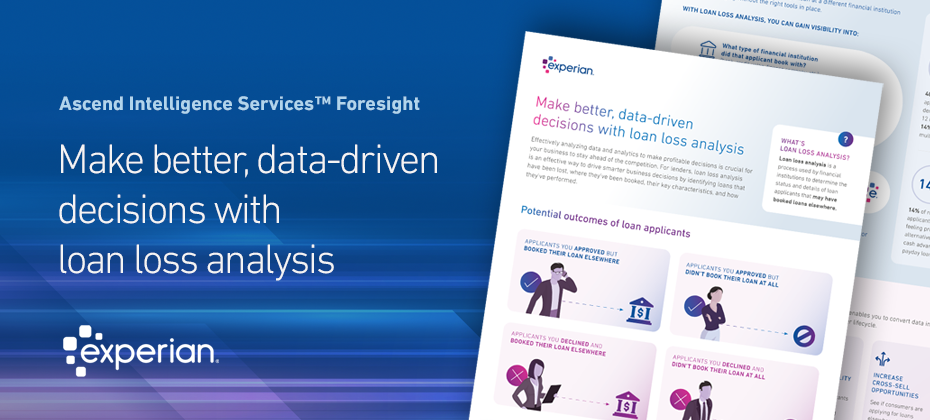
Every data-driven organization needs to turn raw data into insights and, potentially, foresight. There was a time when lack of data was a hindrance, but that’s often no longer the case. Many organizations are overwhelmed with too much data and lack clarity on how to best organize or use it.
Modern business intelligence platforms can help. And financial institutions can use business intelligence analytics to optimize their decisioning and uncover safe growth opportunities.
What is business intelligence?
Business intelligence is an overarching term for the platforms and processes that organizations use to collect, store, analyze and display data and information.
The ability to go from raw data to useful insights and foresight presents organizations with a powerful advantage, and can help them greatly improve their operations and efficiencies. Let’s pause and break down the below terms before expanding on business intelligence.
- Data: The raw information, such as customers’ credit scores. Many organizations collect so much data that keeping it all can be an expensive challenge. Access to new types of data, such as alternative credit data, can assist with decisioning — but additional data points are only helpful if you have the resources or expertise to process and analyze them.
- Information: Once you process and organize data points, you can display the resulting information in reports, dashboards, and other visualizations that are easier to understand. Therefore, turning raw data into information. For example, the information you acquire might dictate that customers with credit scores over 720 prefer one of your products twice as much as your other products.
- Insight: The information tells you what happened, but you must analyze it to find useful and actionable insights. There could be several reasons customers within a specific score band prefer one product over another, and insights offer context and help you decide what to do next. In addition, you could also see what happened to the customers who were not approved.
- Foresight: You can also use information and insights to make predictions about what can happen or how to act in the future given different scenarios. For example, how your customers’ preferences will likely change if you offer new terms, introduce a new product or there’s a large economic shift.
Business intelligence isn’t new — but it is changing.
Traditionally, business intelligence heavily relied on IT teams to sift through the data and generate reports, dashboards and other visualizations. Business leaders could ask questions and wait for the IT team to answer the queries and present the results.
Modern business intelligence platforms make that process much easier and offer analytical insights. Now even non-technical business leaders can quickly answer questions with cloud-based and self-service tools.
Business intelligence vs. business intelligence analytics
Business intelligence can refer to the overall systems in place that collect, store, organize and visualize your data. Business intelligence tends to focus on turning data into presentable information and descriptive analytics — telling you what happened and how it happened.
Business intelligence analytics is a subset of business intelligence that focuses on diagnostics, predictive and prescriptive analytics. In other words, why something happened, what could happen in the future, and what you should do. Essentially, the insights and foresight that are listed above.
How can modern business intelligence benefit lenders?
A business intelligence strategy and advanced analytics and modeling can help lenders precisely target customers, improve product offerings, streamline originations, manage portfolios and increase recovery rates.
More specifically, business intelligence can help lenders uncover various trends and insights, such as:
- Changes in consumers’ financial health and credit behavior.
- How customers’ credit scores migrate over time.
- The risk performance of various portfolios.
- How product offerings and terms compare to competitors.
- Which loans are they losing to peers?
- Which credit attributes are most predictive for their target market?
Understanding what’s working well today is imperative. But your competitors aren’t standing still. You also need to monitor trends and forecast the impact — good or bad — of various changes.
WATCH: Webinar: Using Business Intelligence to Unlock Better Lending Decisions
Using business intelligence to safely grow your portfolio
Let’s take a deeper dive into how business intelligence could help you grow your portfolio without taking on additional risk. It’s an appealing goal that could be addressed in different ways depending on the underlying issue and business objective.
For example, you might be losing loans to peers because of an acquisition strategy that’s resulting in declining good customers. Or, perhaps your competitors’ products are more appealing to your target customers.
Business intelligence can show you how many applications you received, approved, and booked — and how many approved or declined applicants accepted a competitor’s offer. You can segment and analyze the results based on the applicant’s credit scores, income, debt-to-income, loan amounts, loan terms, loan performance and other metrics.
An in-depth analysis might highlight meaningful insights. For example, you might find that you disproportionately lost longer-term loans to competitors. Perhaps matching your competitors’ long-term loan offerings could help you book more loans.
READ: White paper: Getting AI-driven decisioning right in financial services
Experian’s business intelligence analytics solutions
Lenders can use modern business intelligence platforms to better understand their customers, products, competitors, trends, and the potential impact of shifting economic circumstances or consumer behavior.
Experian’s Ascend Intelligence Services™ suite of solutions can help you turn data points into actionable insights.
- Ascend Intelligence Services™ Acquire Model: Create custom machine learning models that can incorporate internal, bureau and alternative credit data to more accurately assess risk and increase your lending universe.
- Ascend Intelligence Services™ Acquire Strategy: Get a more granular view of applicants that can help you improve segmentation and increase automation.
- Ascend Intelligence Services™ Pulse: A model and strategy health dashboard that can help you proactively identify and remediate issues and nimbly react to market changes.
- Ascend Intelligence Services™ Limit: Set and manage credit limits during account opening and when managing accounts to increase revenue and mitigate risk.
- Ascend Intelligence Services™ Foresight: A modern business intelligence platform that offers easy-to-use tools that help business leaders make better-informed decisions.
Businesses can also leverage Experian’s industry-leading data assets and expertise with various types of project-based and ongoing engagements.
Learn more about how you can implement or benefit from business intelligence analytics.


